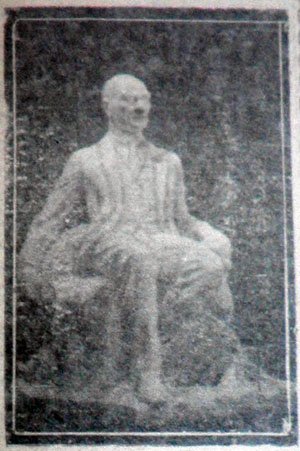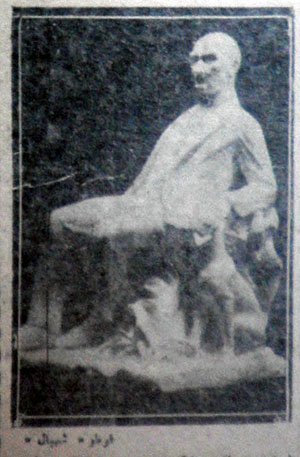106. Today in 1920s Turkey: 22 August 1926 (Model for an Early Atatürk Monument That Was Never Made)

(Picture of model statue, Cumhuriyet, 22 August 1926, no. 821, page 1.)
Türkçe:
Gazinin Yeni Heykeli: Krippel Gazi Paşa’nn yeni bir heykelini daha yaptı.
(Foto Şehbal)
Viyanalı heykeltraş Krippel Gazi Paşa hazretlerinin yeni bir heykelini daha yapmıştır. İki vaziyette birer numunesinin resmini derç ettiğimiz bu eser, Gazi’nin ıstırahat halindeyken bile dinç, kudretli ve muhabbetli oturuşunu ifade etmektedir. Gazi Paşa bu heykelde Zulu/Zuli ismindeki köpeğini okşar vaziyette resmedilmiştir.
English:
Gazi’s New Statue: Krippel Has Made Another Sculpture of Gazi Pasha
(Photograph courtesy of Photo Shahbal)
The Venetian sculptor, Krippel has made another sculpture of the honorable Gazi Pasha. This piece, of which we have included two pictures from different angles, expresses the Gazi’s robust, powerful, and convivial pose even (when) in a restful state. Gazi Pasha is depicted petting his dog named Zulu/Zuli.

Comments:
Statues of the war hero, founding father, and first president Mustafa Kemal “Atatürk” are ubiquitous in modern Turkey. The practice of erecting statues celebrating his achievements began long before his death in 1938. In October of 1926 two of the first statues of this public figure appear in Turkey (one in Istanbul and the other in Konya) as well as a bust in Izmir. Both the Istanbul statue (in Sarayburnu) and the Izmir bust were the works of Austrian sculptor, Heinrich Krippel (1883-1945)—the creator behind the “model” at hand.
This small, insignificant report, accompanied with two photographs, seems to document the beginning stages of a sculpture that was never made. None of the sculptures of Mustafa Kemal Atatürk, referred to simply by his title “Gazi Pasha” in the text, that were made after 1926 by Heinrich Krippel resemble this “seated” figure. Most statues of the leader feature him standing or mounted upon a horse (equestrian). Seated versions exist but they are rare. It is possible that as a seated figure the present example did not emit whatever desired effect so the project that would have surrounded that model was abandoned.
Since a full-scale version of it does not seem to exist, it is possible that the model featured in this report was disposed of never to be seen again. It is also possible that this model was re-purposed (or elements of it) to become the basis for a different work. The closest completed example is the “Oturan Atatürk Anıtı” or “Seated Atatürk Monument” located in the Sümerbank building in Ankara. This work also happened to be made by Krippel in 1938. The seated pose, civilian clothes, and placement of Atatürk’s legs are similar to that of the 1926 model, although the pet dog of the 1926 model has been omitted from the 1938 sculpture. The 1938 sculpture also appears rushed or rather, incomplete as Atatürk appears to be seated directly into the stone from which he was cut. Meaning, in a sense, his body protrudes from the stone in very high relief rather than as a free-standing (seated) figure. It is difficult to imagine that an artist would plan to keep much of the stone surrounding the subject. If this work is as rushed as it appears, it is possible to hypothesize that perhaps the sculptor turned to an older, unused model for inspiration perhaps due to lack of time or resources.

This post has been modified, updated, and re-posted on 22 August 2018. Access the new edition here.
Great post you earned a new follower from @thefollower -_- Like money? Read my blogs for more!